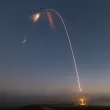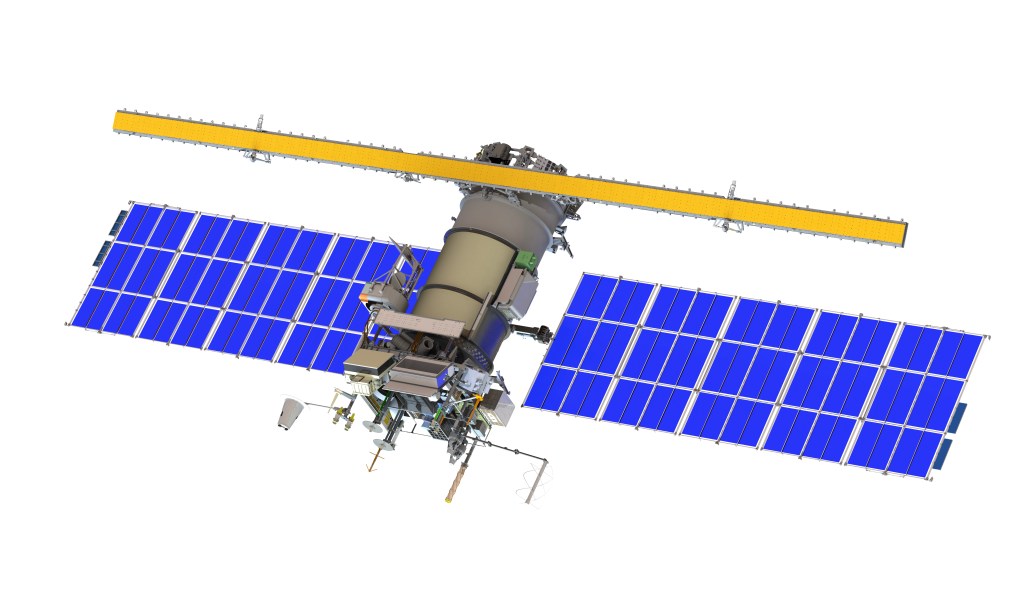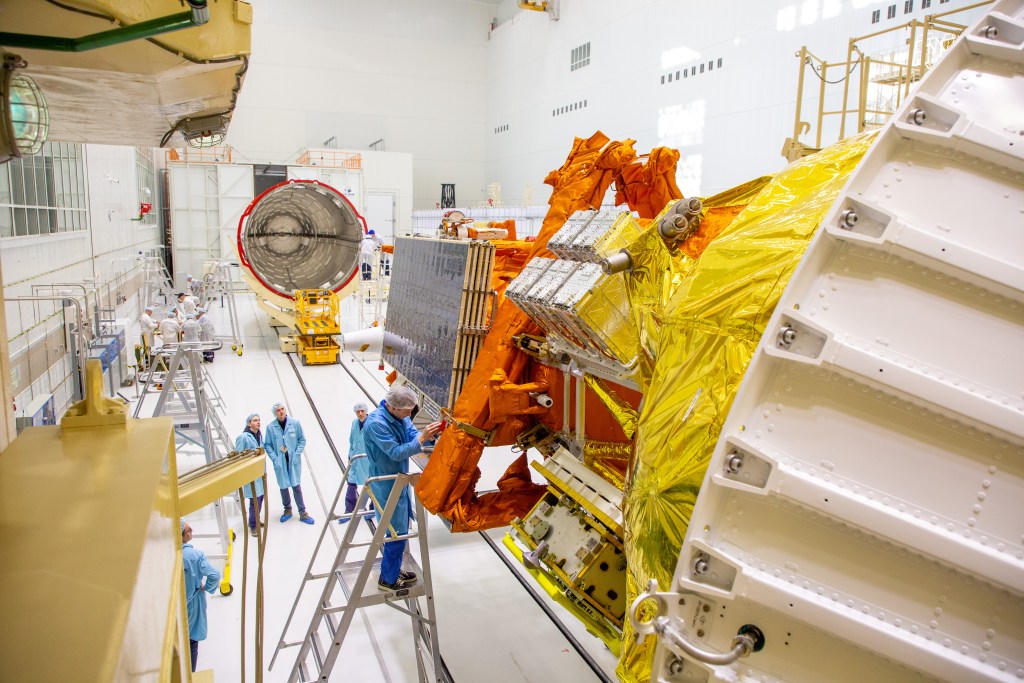Featured Image: Roscosmos
Liftoff Time | February 29, 2024 – 05:43:26.263 UTC | 08:43:26.263 MSK |
|---|---|
Mission Name | Meteor-M 2-4 and others |
Launch Provider | Roscosmos |
Customer | Roscosmos |
Rocket | Soyuz 2.1b with a Fregat-M upper stage |
Launch Location | Site 1S, Vostochny Cosmodrome, Amur Oblast, Russian Federation |
Payload mass | ~2,900 kg (~6,400 lb) for the Meteor-M 2-4 satellite |
Where did the satellites go? | Meteor-M 2-4, to a circular Sun-synchronous orbit (SSO) at 820 km (~510 mi) and 98.57 degrees inclination The other satellites: four into a 500×750 km (~310×470 mi), and 14 into a 485×510 km (~300×320 mi) orbit, all of them with similar inclination to main payload’s one |
Did they attempt to recover the first stage? | No, this is not a capability of Soyuz |
Where did the first stage land? | It likely crashed onto the Zeysky District in Amur Oblast, Russia |
Did they attempt to recover the fairings? | No, this is not a capability of Soyuz |
Were these fairings new? | Yes |
This was the: | – 16th launch from Vostochny Cosmodrome ever – 112th flight of an upper stage of the Fregat family – 1st launch of a Soyuz 2.1b in 2024 – 88th launch of a Soyuz 2.1b variant – 39th orbital launch attempt of 2024 |
Where to re-watch | Official replay |
What’s All This Mean?
Roscosmos prepares to launch the meteorological satellite Meteor-M 2-4 on a Soyuz 2.1b rocket. Additionally, it will carry a total of 18 rideshare passengers hitching a ride with the main spacecraft. The launcher will lift off from Site 1S at the Vostochny Cosmodrome, in Russia.
How Did It Go?
At the predicted time, the Russian launcher ignited its engines and fired them for some seconds, as expected, before lifting off. The Soyuz 2.b nominally performed its flight, passing through every scheduled milestone, e.g., side boosters separation, fairing jettison, central stages and Fregat-M separation, and finally payload deployment. Roscosmos later confirmed the success of the Meteor-M 2-4 and rideshare satellites mission.
Meteor-M 2-4 And Others Mission
The present Meteor mission’s full designation is Meteor-M No. 2-4, consequently implying the spacecraft belongs to a series of satellites. In fact, the Meteor-M series was developed by NPP VNIIEM as an advancement of the Meteor-3M series under the sponsorship of Roscosmos, aiming to modernize Russia’s national meteorological satellite system. The following list shows the instruments carried by the Meteor-M satellite series, as shown on the World Meteorological Organization’s website, OSCAR:
- IKFS-2 – advanced IR sounder for atmospheric temperature and humidity profiles (not on Meteor-M No. 1)
- KMSS – multi-channel scanning unit for Earth surface monitoring
- MSU-MR – low-resolution multispectral scanner for global and regional cloud cover mapping
- MTVZA-GY – imager/sounder for atmospheric temperature and humidity profiles, sea surface wind
- SSPD – data collection and transmission system (not on Meteor-M No. 2-3)
- IKOR-M – broadband radiometer sensing outgoing short-wave signals (not on Meteor-M No. 2-3)
- GGAK-M/RIMS-M – mass spectrometer utilizing radio-frequency to identify human influences in the ionosphere and the upper atmosphere
- GGAK-E/SKIF-6 – spectrometer to detect corpuscular radiation that aims at probing incoming solar radiation
- GGAK-E/GALS-E – cosmic rays detector studying this kind of radiation arriving to our planet
- Severjanin-M – synthetic aperture radar operating in the X-band, purposed for all-weather land observation (not on Meteor-M No. 2-4)
- MeteoSAR – another synthetic aperture X-band radar that will perform all-weather observations of land, oceans, and also ice (only on Meteor-M No. 2-4)
The Meteor-M 2-4 Satellite
Similarly to the 2-3 spacecraft, the primary objectives of the Meteor-M 2-4 satellite involve a range of important tasks, including climate and environmental monitoring, exploration of Earth’s natural resources, surveillance of solar activity in the vicinity of our planet, as well as the acquisition of data from automated data collection platforms. Additionally, the satellite features the COSPAS-SARSAT search and rescue system. Finally, No. 2-4 will study the interactions of the oceans and our atmosphere with a particular focus on how those influence weather conditions.
Moreover, Meteor-M 2-4 features an onboard radar complex based on an active phased array antenna, a shortwave reflected radiation meter, and a radio frequency mass spectrometer. These instruments pave the way for all-weather radar surveillance of the Northern Sea Route while broadening the scope of monitored parameters. It has two deployable solar arrays, batteries, and an on-orbit lifespan of five years.
Previous Meteor-M flights
The following is a list summarizing all launches in the series, and the result of each mission.
- Meteor-M No. 1, September 17, 2009, at 15:55 UTC, success.
- Meteor-M No. 2, July 8, 2014, at 15:58 UTC, success.
- Meteor-M No. 2-1, November 28, 2017, at 05:41 UTC, failure in upper stage.
- Meteor-M No. 2-2, July 5, 2019, at 05:41 UTC, success.
- Meteor-M No. 2-3, June 27, 2023, at 11:34 UTC, success.
Accompanying Satellites
Eighteen smaller satellites coming from both Russian and international entities will fly together with the Meteor-M 2-4 satellite, according to official authorities. So far, not much has been disclosed, but here is a list of them:
- 16x SITRO-AIS CubeSats for Sputnix, numbers 13 through 28.
- Pars-1, an Iranian MiniSat featuring three cameras and a mass of about 134 kg (~300 lb).
- Zorkiy-2M No. 2.
- Marafon-D GVM, probably a mass simulator, given that the actual Marafon-D would have been delayed.
What Is Soyuz 2.1b?
Roscosmos’s Soyuz is a multi-use medium-lift launch vehicle that was introduced in far 1966 and since then has been the workhorse of the Soviet/Russian space program. It is capable of launching civilian and military satellites, as well as cargo and crewed missions to the ISS. Over the decades, several variants of the Soyuz rocket have been developed. Soyuz 2.1b is one of its latest iterations that belongs to the Soyuz 2 rocket family.
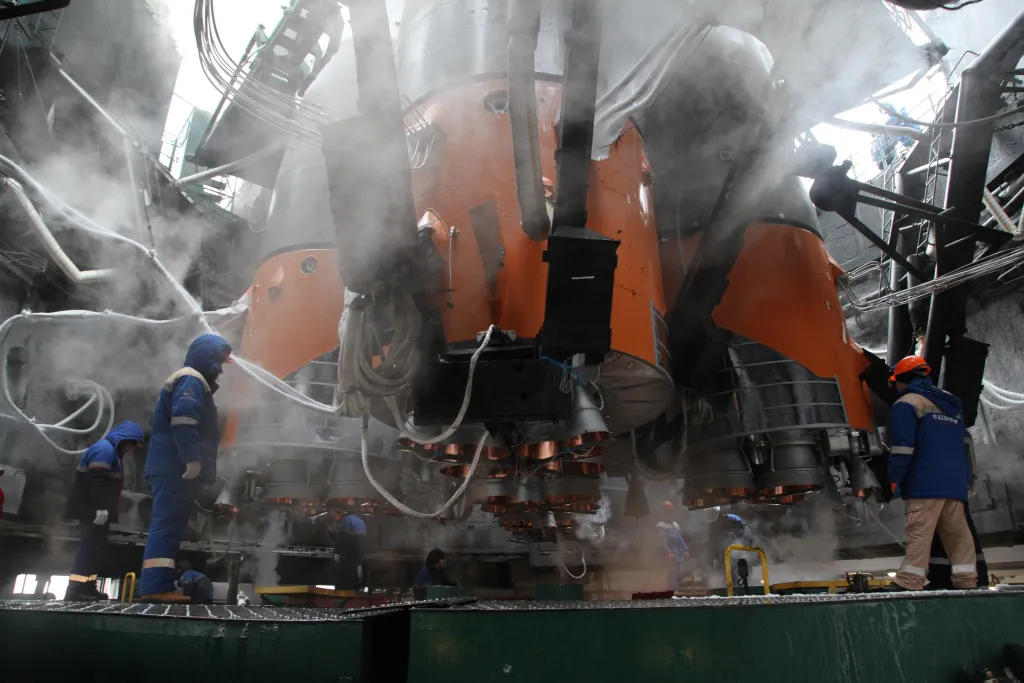
The rocket consists of three stages, with all of them being expendable. When launching to the ISS, Soyuz 2 flies carrying either a Progress capsule or a Soyuz spacecraft.
Soyuz 2.1b is about 46.3 meters (152 ft) in height and 2.95 meters (9 feet) in diameter. The vehicle’s total lift-off mass is approximately 312,000 kg (688,000 lb). The rocket’s payload lift capacity to low-Earth orbit (LEO) is between 6,600 and 7,400 kg depending on the launch site.

Stages
| Engines | Thrust*, Sea Level [kN (lbf)] | Thrust*, Vacuum [kN (lbf)] | ISP**, Sea Level [s] | ISP**, Vacuum [s] | |
| First Stage | 4x RD-107A | 840 (188,720) | 1,020 (229,290) | 263 | 320 |
| Second Stage | 1x RD-108A | 792 (178,140) | 922 (207,240) | 258 | 321 |
| Third Stage | 1x RD-0124 | – | 294 ( 66,094) | – | 359 |
**ISP: specific impulse
Side Boosters
The first stage of the Soyuz 2.1b rocket comprises four side boosters powered by RD-107A engines. Each one of the boosters has a conical shape and a dry weight of 3,784 kg. It is approximately 19.6 meters in length, with a diameter of 2.7 meters. Each side booster has two vernier thrusters that serve for purposes of flight control.
The RD-107A engine runs on rocket-grade kerosene (RP-1) and liquid oxygen (LOx). The propellants are stored in the pressurized aluminum alloy tanks, with the kerosene tank located in the cylindrical part of the booster, and the LOx one, in the conical section. Each one of those engines have four combustion chambers and together they are capable of producing a thrust of 840 kN at sea level and 1,020 kN in a vacuum.
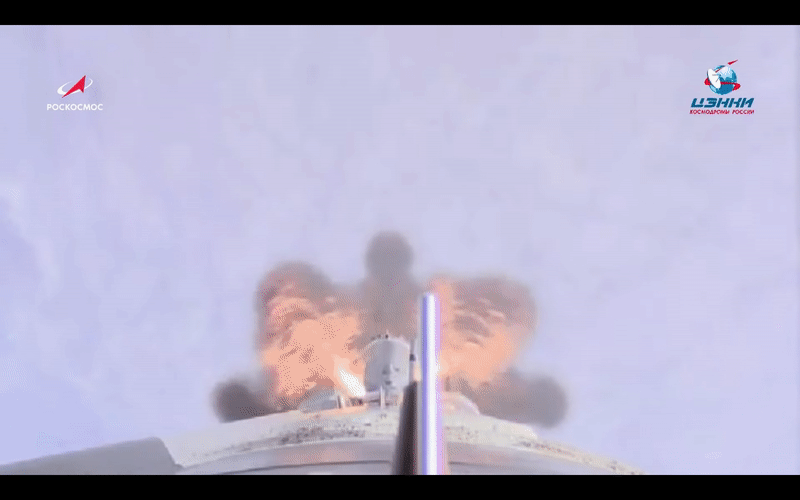
Perhaps, the most spectacular moment of the Soyuz 2 rocket’s launch is the separation of the first stage. It happens approximately 2 minutes after the launch. The boosters perform a pattern, known as the “Korolev cross” (named after Sergei Korolev, a very important figure of the USSR space program and history).
Second And Third Stages
The center core stage is powered by a single RD-108A engine, and the upper stage is fitted with a single RD-0124 engine. Both of these engines run on RP-1 and LOx and have four combustion chambers. The second stage is 27.1 meters long, with a diameter of 2.95 meters, and a dry mass of 6,545 kg. It has four vernier thrusters for three-axis flight control.
The third stage of a Soyuz 2 rocket has a height of 6.7 meters, a diameter of 2.7 meters, and a dry mass of 2,355 kg. One interesting thing about the RD-0124 engine on this stage is that it starts its ignition sequence prior to stage separation. This process receives the name of “hot fire staging,” or “hot staging,” too.
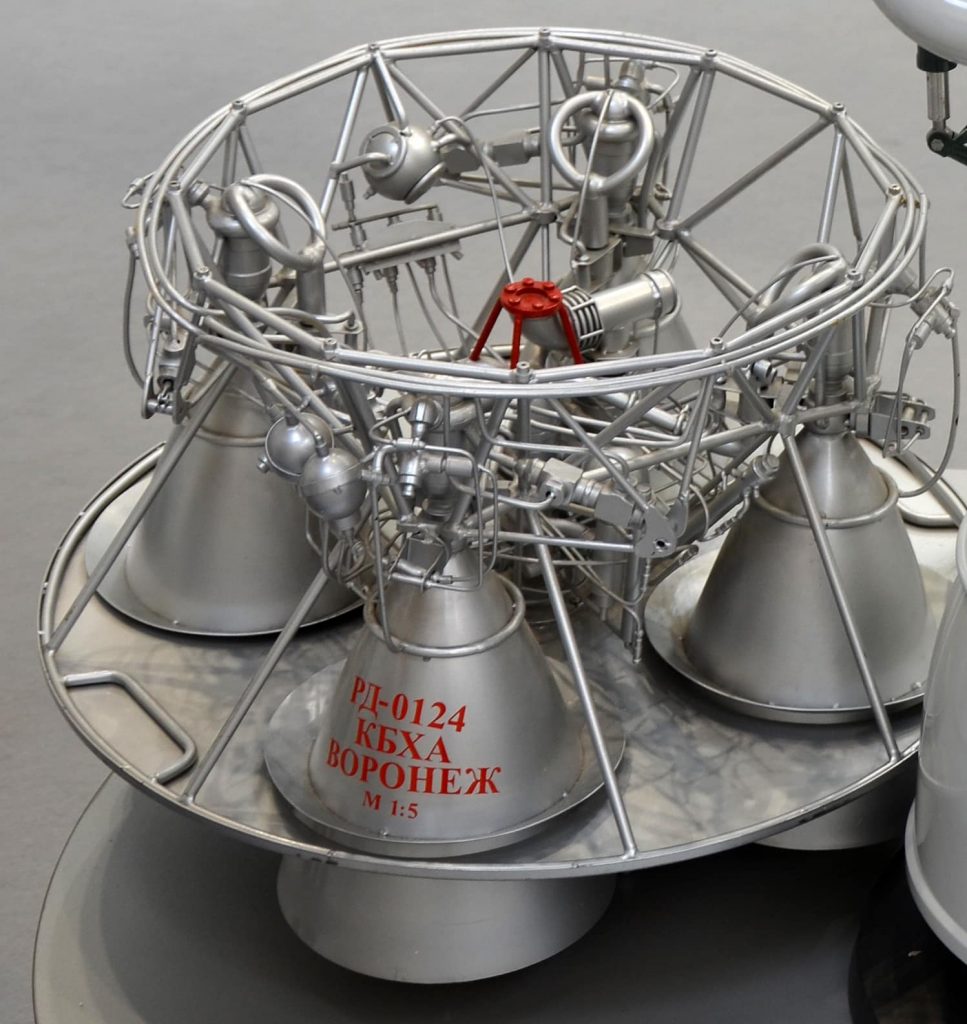
Fregat Upper Stage
Flight qualified in 2000, the Fregat upper stage is an autonomous and flexible stage designed to operate as an orbital vehicle. It extends the Soyuz launcher’s capability, covering a full range of orbits (LEO, SSO, MEO, GTO, GEO and Earth escape). Fregat is independent of all the other stages, as it has its own guidance, navigation, attitude control, tracking, and telemetry systems. The S5.92 engine burns storable propellants – UDMH (unsymmetrical dimethylhydrazine) and NTO (nitrogen tetroxide). The Fregat upper stage remains encapsulated in a fairing with the payload and a payload adaptor/dispenser. The upgraded Fregat-M has additional ball-shaped compartments on top of its propellant tanks, which allows to increase the load capability of the propellant.


